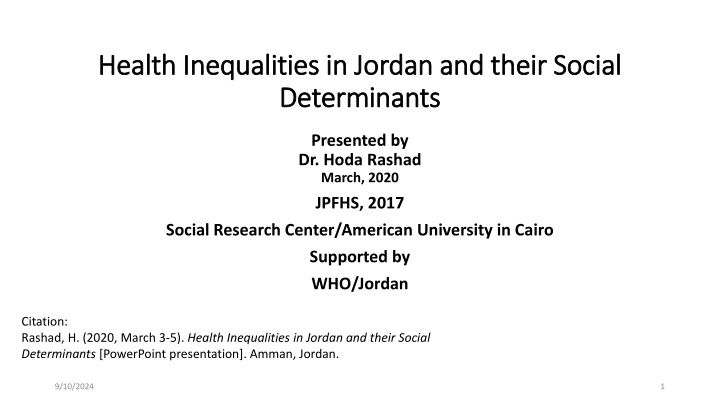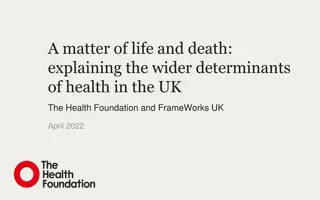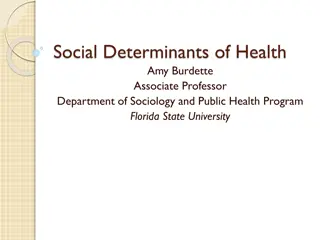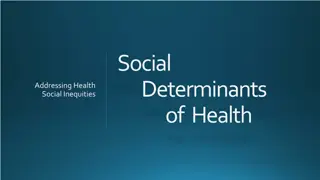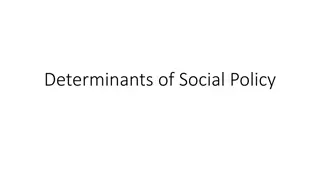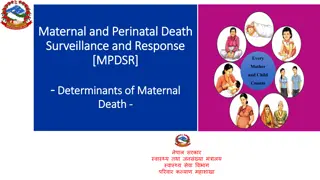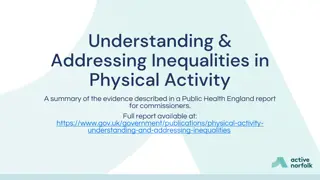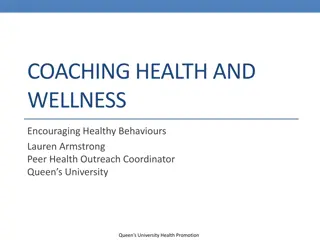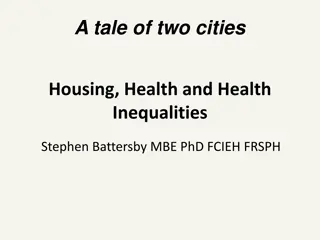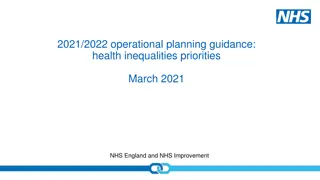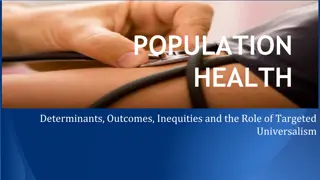Health Inequalities in Jordan: Social Determinants and Priorities
This study by Dr. Hoda Rashad in Jordan explores health inequalities and their social determinants, analyzing 85 health indicators in various categories like child health, non-communicable diseases, reproductive health, and health system performance. Key findings reveal progress in child mortality, but challenges remain in maternal mortality and overall health ranking. The methodology used negative health formulation and investigated social patterns through stratifiers like geographic residence, wealth, education, and nationality. Recommendations include addressing priority challenges to tackle health inequalities in Jordan.
Download Presentation

Please find below an Image/Link to download the presentation.
The content on the website is provided AS IS for your information and personal use only. It may not be sold, licensed, or shared on other websites without obtaining consent from the author.If you encounter any issues during the download, it is possible that the publisher has removed the file from their server.
You are allowed to download the files provided on this website for personal or commercial use, subject to the condition that they are used lawfully. All files are the property of their respective owners.
The content on the website is provided AS IS for your information and personal use only. It may not be sold, licensed, or shared on other websites without obtaining consent from the author.
E N D
Presentation Transcript
Health Inequalities in Jordan and their Social Health Inequalities in Jordan and their Social Determinants Determinants Presented by Dr. Hoda Rashad March, 2020 JPFHS, 2017 Social Research Center/American University in Cairo Supported by WHO/Jordan Citation: Rashad, H. (2020, March 3-5). Health Inequalities in Jordan and their Social Determinants [PowerPoint presentation]. Amman, Jordan. 9/10/2024 1
Evidence on Social Patterns, Trend Social Inequalities in Health Sector Performance, Ins. Cov. Priority Challenges, Policy Recommendations 9/10/2024 2
What did we do in the study? Analyzed 85 health indicators from JPFHS 2017 classified in 5 broad groups: Child health and wellbeing: o Impact: Neonatal/infant/ under 5 mortality o Risk factors: infant/ child health/ child development NCDs and Adult health: o Impact: diagnosed diabetes o Risk factors for NCDs(obesity, smoking, anemia, others) Reproductive health o Risk factors (Social, HIV/AIDS related, Domestic violence related) health system performance o Infant and child health o Maternal health o Family planning o Other RH Health system capacity (difficulty facing women in access health services) Health insurance coverage (general population, users of outpatient and inpatient services
Methodology All indicators were formulated in negative health direction Three prevalence categories: very high (40% +), high (20-<40%), moderate low (< 20%) Four stratifiers were used to investigate the social patterns of health. These are Geographic residence (governorates), Household wealth, Education, and nationality Inequality was assessed for each indicator and stratifiers in terms of The Gap between the best and worst off performing social group Summary inequality measure to assess degree of inequality in the distribution Three degrees: severe > 10%, moderate 5-10%, low < 5%
Key Findings WHAT ARE MAIN HEALTH PRIORITIES? Jordan already achieved SDG for child mortality Neonatal = 11 (SDG at least 12) Under 5 mort. = 19 (SDG at least 25) But is this enough? Jordan rank < 5 mort. 38 among 52 countries in HHD MMR = 29.5 per 100,000 live births (SDG < 70) 9/10/2024 5
Key Findings Improvements (34 out of 66 decreased) + Unfinished Agenda (32 increased); 63 out of 85 indicators > 20% Moderate/ low prevalence, 22 Very high prevalence , 31 High prevalence, 32 Figure 1 Distribution of health indicators by their prevalence classification 9/10/2024 6
High prevalence of risk factors requiring social interventions Socially Driven SDG risk factor indicators require accelerated actions (Child dev., smoking, early mar., adolescent CB, FP, violence against women) Exceptions: Births attended by skilled personnel (99.7%), Civil Registration (98%) Health Sector Driven 9/10/2024 7
Prevalence of health risk factors indicators 100 90 80 70 60 50 40 30 20 10 0 Smoking women 15-49 No knowledge of STI Risky birth intervals (23 months) Anemia among women 15-49 Consanguinity Obesity /overweight among women 15-49 Multiparity (5+ children) Never heard of pap test Low Birthweight Any violent discipline children 1-14 years No Knowledge of MTCT No food rich in iron (6-23 months) No food rich in vitamin A (6-23 months) No minimum dietary diversity (6-23 months) Discriminatory attitudes against PLWH Smoking men 15-49 Women who does not own health care decision Early marriage (<18 years) Experience of physical violence in the past 12 months Any form of spousal violence in the past 12 months Anemia children 6-59 months No minimum meal frequency (6-23 months) Agree to wife beating for at least one reason men 15-50 Adolescent child bearing (<18 years) Any form of spousal violence in the ever No comprehensive knowledge of HIV Agree to wife beating for at least one reason women 15-49 No minimum acceptable diet (6-23 months) No comprehensive knowledge of HIV for young (15-24) No comprehensive knowledge of HIV for young (15-24) No knowledge of STI Very small/small in size Children not on the developmental track No knowledge of HIV/AIDS No Knowledge of MTCT No knowledge of HIV/AIDS Physical violence is necessary Discriminatory attitudes against PLWH No breast exam self or professional Women never sought help against spousal violence Children <5 years left with inadequate care Not able to negotiate sexual intercourse No comprehensive knowledge of HIV Experience of physical violence since 15 year of age RF_Infant health RF_ child nutrition RF- Child development RF_NCDs RF_ Social RH RF_ HIV/AIDS related (women) RF_ HIV/AIDS related (men) RF_Domestic violence related
Health sector performance on track: large no. of indicators <20% Despite challenges on health sector capacity front Particularly infant + maternal health Except: premarital tests, place for HIV test. (other RH ind.) 9/10/2024 9
Prevalence of health sector indicators 100 90 80 70 60 50 40 30 20 10 0 No knowledge of ORS Unavailability of female provider Distance to health care facility No postnatal care <2 days No use of contraceptives No premarital exam women No premarital exam women's husband No breastfeeding Use of traditional methods No information on test place for HIV/AIDS men Not receiving all basic vaccination 12-23 months Not receiving vitamin A supplement (6-59 months) No antenatal care regular No breastfeeding within 1 day of birth No iron tablet during pregnancy No information on test place for HIV/AIDS women Need to take transportation No postnatal care for child Children with diarrhea not seeking treatment or advice Not receiving iron supplement (6-59 months) Unaffordability of the health care service No postnatal check within the first 2 days of birth Not receiving any age appropriate vaccination 12-23 Nonusers of FP did not discuss FP either with field workers Not receiving all age appropriate vaccination 12-23 months Unmet need No postnatal care Cesarean section No antenatal care Children with fever not seeking treatment or advise or health facility months HP_Infant health HSP_Child health HSP_Maternal health HSP_FP HSP_Other RH Health sector capacity
%No health insurance coverage (15-49) = 44% Higher coverage of women than men (58% vs 50%) More coverage in rural than urban areas (75% vs 52%) 9/10/2024 11
Other Findings WHATISTHEDISTRIBUTIONOFHEALTHPRIORITIESFORDIFFERENT SOCIALGROUPSANDWHICHSOCIALGROUPISTHEMOST VULNERABLESOCIALGROUP? (MOSTVULNERABLE, MORETHANONESOCIALGROUPWITH RELATIVELYLARGERSHARE) WHATISTHEDISTRIBUTIONOFSEVERITYOFHEALTHINEQUALITYFOR DIFFERENTSTRATIFIERANDWHICHSTRATIFIERISMORESEVERELY UNEQUAL? WHATARETHETRENDSINPREVALENCEANDINEQUALITYSUMMARY MEASURESBETWEEN 2012 AND 2017? 9/10/2024 12
Summary Measures of Inequality: Average measure of the difference between the actual burden of ill health of the social group given their size and the expected burden if they are exposed to equal levels. Average excess burden that needs to be addressed They move discussion from: Targeting to achieving a fair distribution inequality to inequity Selected Findings of Inequalities Generally speaking the summary measures of inequality in Jordan is much lower than other Arab countries (4 other Arab countries) A number of indicators show severe inequality. The education and governorates reflect more severe inequality than wealth and nationality 9/10/2024 13
INEQUALITY INEQUALITY SUMMARY SUMMARY MEASURES MEASURES FOR FOR HEALTH HEALTH INDICATOR INDICATOR FOR FOR ALL ALL STRATIFIERS STRATIFIERS Inequality summary measure Inequality summary measure indicator Nation. Wealth indicator Health aspects Educ. Nation. Wealth Gov. Health aspects Educ. Gov. Neonatal mortality 10.1 -1 -4.5 6.2 Adolescent child bearing (<18 years) Women who does not own health care decision Early marriage (<18 years) Multiparity (5+ children) Consanguinity Risky birth intervals (23 months) No knowledge of HIV/AIDS No Knowledge of MTCT No knowledge of STI Discriminatory attitudes against PLWH No comprehensive knowledge of HIV for young (15-24) No comprehensive knowledge of HIV No knowledge of HIV/AIDS No Knowledge of MTCT No knowledge of STI Discriminatory attitudes against PLWH No comprehensive knowledge of HIV No comprehensive knowledge of HIV for young (15-24) Experience of physical violence in the past 12 months Any form of spousal violence in the past 12 months Experience of physical violence since 15 year of age Any form of spousal violence in the ever Not able to negotiate sexual intercourse Agree to wife beating for at least one reason women 15-49 Women never sought help against spousal violence Agree to wife beating for at least one reason men 15-50 23.2 7.7 6.3 8.4 6.6 3.5 19.5 3.5 4.8 1.4 0.7 1.3 13.2 3.2 5.3 2.9 3.0 6.4 13.2 11.4 10.1 9.1 4.8 13.3 4.5 4.2 -46.2 -35.5 37.7 -13.3 -20.8 12.5 -10.7 -29.8 10.3 -8.9 -16.7 -7.3 -10.0 -6.1 -0.9 -6.7 -23.8 10.1 -1.3 -3.8 -6.4 -7.7 -0.4 -0.4 -1.0 -2.4 -1.7 -2.0 -15.2 -15.1 -4.4 -6.2 -0.1 -2.7 1.4 0.6 -0.8 -1.5 -1.0 -1.5 -6.8 -11.8 -5.9 -8.7 -8.1 -14.0 -5.5 -10.7 -9.4 -10.3 -12.8 -7.4 -1.1 -1.1 -0.4 0.5 Child mortality Infant mortality 6.8 -2 -9.6 7.6 Under 5 mortality 6.8 -1.7 -7.7 5.6 RF_ Social RH Very small/small in size 7.8 -11.8 -10.2 5.1 RF_Infant health 2.4 1.7 4.3 Low Birthweight 6.0 -6.5 -10.0 3.8 Anemia children 6-59 months 9.3 -11.0 -6.4 0.9 No food rich in vitamin A (6-23 months) 5.9 -4.5 -4.9 1.6 0.4 1.2 0.1 0.6 0.4 3.1 1.2 0.6 0.3 0.4 0.2 2.8 0.3 4.0 2.0 4.4 2.7 2.1 0.5 No minimum meal frequency (6-23 months) 3.5 -5.2 -5.8 3.1 RF_ child nutrition RF_ HIV/AIDS related (women) No food rich in iron (6-23 months) 5.6 -3.5 -1.5 0.9 No minimum dietary diversity (6-23 months) 6.7 -5.8 -2.4 1.8 No minimum acceptable diet (6-23 months) 2.9 -2.9 -1.5 1.4 Physical violence is necessary 7.8 -3.8 -0.4 1.8 Children <5 years left with inadequate care 4.9 2.7 2.4 1.7 RF- Child development Children not on the developmental track 5.8 -4.9 -5.2 1.6 RF_ HIV/AIDS related (men) Any violent discipline children 1-14 years 3.4 -3.4 -2.5 0.5 Diabetes (18+ years/ women) 4.5 -3.3 -41.5 1.3 Diabetes (18+ years/ men) 5.5 6.1 -14.8 2.8 Diabetes Diabetes (60+ years/ men) 3.7 0.1 1.7 1.6 Diabetes (60+ years/ women) 3.1 -1.7 -4.3 1.2 Smoking women 15-49 18.7 13.7 -3.7 2.6 RF_Domestic violence related Anemia among women 15-49 2.0 -2.1 -1.7 0.2 Smoking men 15-49 2.8 -5.3 -1.3 0.9 RF_NCDs Obesity /overweight among women 15-49 2.0 -3.4 -2.7 0.8 Never heard of pap test 8.8 -13.8 -11.1 9.0 No breast exam self or professional very high 2.1 -4.0 -3.2 1.5 moderate/ low high
Alongside improvements in health, severity of inequality increases BENEFITS NOT EQUALLY SHARED 9/10/2024 15
INEQUALITY MEASURES AND THEIR SEVERITY CLASSIFICATION FOR THE HEALTH INDICATORS BY THEIR PREVALENCE CLASSIFICATION Very High Prevalence Indicators Moderate Prevalence Indicators Stratifiers Indicators Stratifiers Subcategory Child nutrition No minimum acceptable diet (6-23 months) No minimum dietary diversity (6-23 months) No food rich in iron (6-23 months) RF_Child development RF_NCDs No breast exam self or professional Obesity /overweight among women 15-49 Smoking men 15-49 Anemia among women 15-49 RF_HIV/AIDS related (women) Discriminatory attitudes against PLWH No knowledge of STI No Knowledge of MTCT RH_HIV/AIDS related (men) No comprehensive knowledge of HIV Discriminatory attitudes against PLWH No knowledge of STI No Knowledge of MTCT RF_Domestic violence related Agree to wife beating for at least one reason women 15-49 HSP _Child health Not receiving vitamin A supplement (6-59 months) Children with diarrhea not seeking treatment or advice HSP_FP Nonusers of FP did not discuss FP either with field workers or health facility HSP_Other RH No information on test place for HIV/AIDS women No information on test place for HIV/AIDS men No premarital exam women's husband No premarital exam women Health insurance coverage severe GOV Wealth Education Nationality 2.9 6.7 5.6 -2.9 -5.8 -3.5 -1.5 -2.4 -1.5 1.4 1.8 0.9 Nationality Indicator group Education Wealth Indicators GOV Any violent discipline children 1-14 years 3.4 -3.4 -2.5 0.5 RF_Child development Children <5 years left with inadequate care Physical violence is necessary Smoking women 15-49 Women who does not own health care decision Adolescent child bearing (<18 years) No knowledge of HIV/AIDS No knowledge of HIV/AIDS 4.9 7.8 18.7 7.7 23.2 19.5 13.2 2.7 -3.8 13.7 -13.3 -46.2 -6.7 -15.2 2.4 -0.4 -3.7 -20.8 -35.5 -23.8 -15.1 1.7 1.8 2.6 12.5 37.7 10.1 3.1 2.1 2.0 2.8 2.0 1.3 0.7 1.4 4.8 3.5 6.4 3.0 2.9 5.3 3.2 4.2 4.5 13.3 2.9 2.2 3.2 -4.0 -3.4 -5.3 -2.1 -1.7 -1.0 -0.4 -6.4 -1.3 -1.0 -0.8 1.4 -0.1 -4.4 -0.4 -1.1 -12.8 -2.8 -1.1 -3.8 -3.2 -2.7 -1.3 -1.7 -2.0 -2.4 -0.4 -7.7 -3.8 -1.5 -1.5 0.6 -2.7 -6.2 0.5 -1.1 -7.4 -1.9 -0.5 -2.7 1.5 0.8 0.9 0.2 0.4 0.6 0.1 1.2 0.4 0.2 0.4 0.3 0.6 1.2 0.5 2.1 2.7 0.6 0.3 1.6 RF_NCDs No comprehensive knowledge of HIV No comprehensive knowledge of HIV for young (15-24) RH_HIV/AIDS related RF_Domestic violence related HSP_ infant health Experience of physical violence in the past 12 months 13.2 -6.8 -11.8 2.8 No comprehensive knowledge of HIV for young (15-24) No breastfeeding within 1 day of birth No postnatal check within the first 2 days of birth No postnatal care for child No breastfeeding Not receiving all age appropriate vaccination 12-23 months No knowledge of ORS Not receiving all basic vaccination 12-23 months Not receiving any age appropriate vaccination 12-23 months No postnatal care <2 days No postnatal care No antenatal care regular No antenatal care Use of traditional methods Unmet need 9.0 13.7 13.2 11.5 -3.5 -7.7 -8.0 -3.4 3.0 -8.9 -10.1 1.8 2.2 7.9 8.9 3.3 Agree to wife beating for at least one reason men 15-50 Women never sought help against spousal violence HSP_Child health 6.0 3.8 1.5 8.3 9.3 6.9 -8.5 0.7 -15.9 -0.8 14.8 11.2 Not receiving iron supplement (6-59 months) 14.3 -7.3 -10.1 9.3 2.2 0.3 -1.9 1.4 HSP_Maternal health 8.2 12.4 9.7 17.8 5.8 2.9 -10.1 -14.6 -16.1 -9.4 -0.5 -2.9 -10.8 -15.6 -10.0 -16.9 4.1 -1.4 6.5 9.8 9.2 7.5 2.2 4.0 2.6 4.4 2.6 2.9 14.0 -5.2 -3.6 2.9 -0.3 -0.5 -6.2 -9.2 -13.3 -14.2 -10.3 1.5 1.4 0.3 2.6 2.9 HSP_FP Not covered by any health insurance men (15-49) Not covered by any health insurance women (15-49) 17.3 1.4 -8.4 6.9 low moderate
Increasing in degree of severity bet 2012 and 2017 governorate 46 indicators out of 85 increased wealth, education 25,20 indicators increased 9/10/2024 17
HS AND INS, COV. DEGREE OF INEQUALITIES Inequality summary measure Wealth -3.4 -8.0 -7.7 -3.5 -7.3 0.7 -8.5 3.8 -6.8 -3.8 -1.1 -2.8 -9.4 -16.1 -14.6 -10.1 -3.3 2.6 -2.9 -0.5 -1.4 indicator Health aspects Gov. 11.5 13.2 13.7 9.0 14.3 6.9 9.3 6.0 9.5 3.2 2.2 2.9 17.8 9.7 12.4 8.2 8.3 2.7 2.9 5.8 2.4 Educ. 1.8 -10.1 -8.9 3.0 -10.1 -0.8 -15.9 1.5 -6.9 -2.7 -0.5 -1.9 -16.9 -10.0 -15.6 -10.8 -4.9 4.5 -1.4 4.1 -6.1 Nation. 3.3 8.9 7.9 2.2 9.3 11.2 14.8 8.3 1.8 1.6 0.3 0.6 7.5 9.2 9.8 6.5 1.6 2.5 4.0 2.2 1.3 No breastfeeding No postnatal care for child No postnatal check within the first 2 days of birth No breastfeeding within 1 day of birth Not receiving any age appropriate vaccination 12-23 months Not receiving all basic vaccination 12-23 months No knowledge of ORS Not receiving all age appropriate vaccination 12-23 months Children with fever not seeking treatment or advise Children with diarrhea not seeking treatment or advice Not receiving vitamin A supplement (6-59 months) Not receiving iron supplement (6-59 months) No antenatal care No antenatal care regular No postnatal care No postnatal care <2 days No iron tablet during pregnancy Cesarean section Unmet need Use of traditional methods No use of contraceptives Nonusers of FP did not discuss FP either with field workers or health facility No premarital exam women No premarital exam women's husband No information on test place for HIV/AIDS men No information on test place for HIV/AIDS women Unavailability of female provider Distance to health care facility Unaffordability of the health care service Need to take transportation No insurance for inpatient users No insurance for outpatient users Not covered by any health insurance women (15-49) Not covered by any health insurance men (15-49) severe HP_Infant health moderate HSP_Child health low HSP_Maternal health HSP_FP 2.2 0.3 -1.9 1.4 2.9 2.6 4.4 2.6 7.5 13.3 11.2 9.4 -0.3 2.9 -3.6 -5.2 -17.1 -23.4 -26.3 -15.2 -1.2 0.3 1.4 -0.5 -14.2 -13.3 -9.2 -6.2 -14.0 -17.9 -22.0 -12.7 1.2 -5.1 -8.4 -10.3 2.6 0.3 1.4 1.5 5.9 7.6 12.3 7.2 22.8 13.1 6.9 2.9 HSP_Other RH Health sector capacity Health insurance coverage 11.0 17.3 14.0
Conceptualization of Systematic Inequalities Inequalities largely shaped outside HS (SDH) Unfairness consideration Multi level SDHI (CSDH) Upstream determinants 9/10/2024 19
Conceptualization Health inequalities are inequalities driven by people s Unfair access to resources and opportunities Macro political/economic forces + - Intermediary Social Arrangements (gender, culture and religion) - Public services: MS care, Ins. Cov. Inequality in HS performance & Capacities Ins. Cov. Unfair: Not responsive to differentiated needs 9/10/2024 20
Priorities & Policy Recommendation Jordan Strategies Priorities Supported by Evidence Speak to SDG Targets Recognized extra burden of some gov. + Low income social groups Articulated national strategies (Health, NCD, RH, ) Contributions of this report More detailed and recent evidence ( particularly on risk factors) Two more vulnerable groups (low educ., Syrians) Remaining HS challenges, but more serious challenges on social front Key contributions Emphasis & Interpretation of systematic inequalities unfairness social threat unresponsiveness of HS, Ins. cov. 9/10/2024 Increasing trend of inequalities 21
Mainstreaming Equity in Policy & Actions at Each Entry Level & Each Actor Adaptation to priority health challenges Evidence based plans/actions 9/10/2024 Methodology developed for SRH 22
Specific Recommendations 1. Improve Equitable Performance of the Health Sector Target inequitable dist. of risk factors(level A); Intersectoral Adequate & fair health resources 2. Hold Social Sectors Responsible for Health Lead responsibility of social sectors (level C); Sectoral initiatives Equitable (level B); PHC (level C); Target, time bound, quantified equality goals for health. 9/10/2024 23
Specific recommendations 3. Systematic Measurements and Monitoring of Health Inequities Data sources (routine + surveys) HIS ISH 4. Pushing Equity to the Forefront as a Development Goal and a Whole of Government and Society Performance Measure Articulating health as a whole of government responsibility and developing an equity-based strategies for health and plans. Enforcing health impact assessment in all policies. The Higher Health Council is well poised to play a stewardship role to place HE as a benchmark for a fair and develop society, and to monitor the implementation of the whole of government responsibility and the accountability process. 9/10/2024 24
